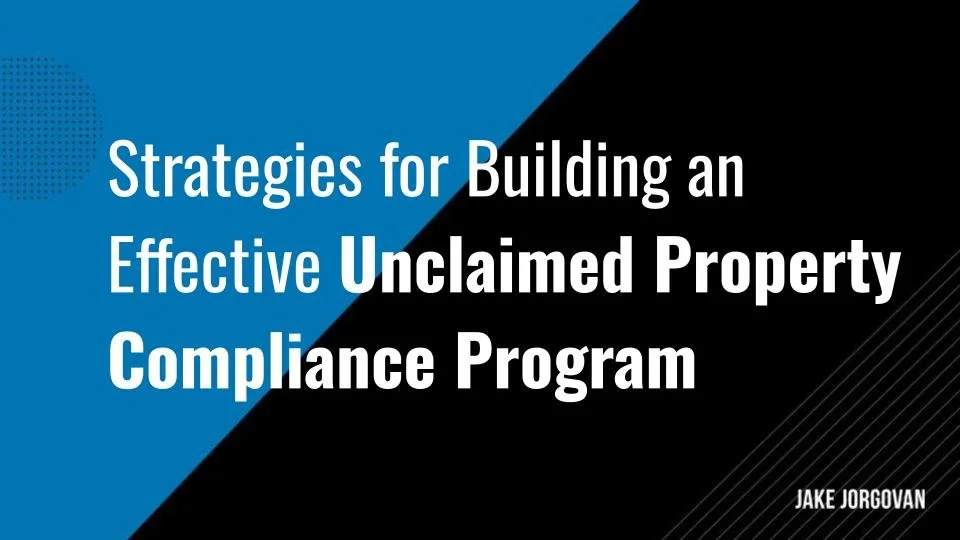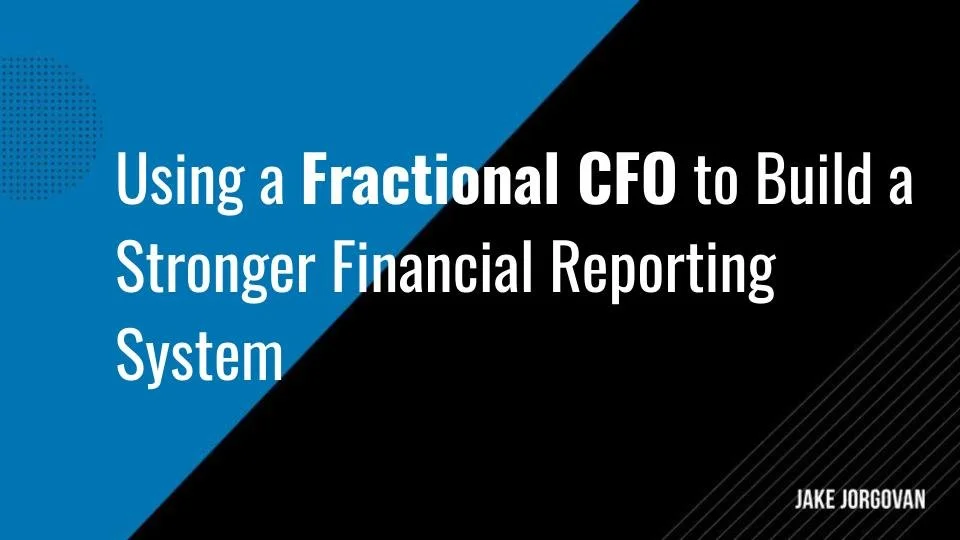Effective Unclaimed Property Compliance Program: 5 Best Strategies to Avoid Penalties & Ensure Compliance
Unclaimed property is big business. In 2020, unclaimed property programs returned over $2.8 billion to rightful property owners.
Unclaimed property compliance is a growing concern for businesses.
According to Forbes, “Fifty-five reporting jurisdictions require companies to file annual reports and escheat abandoned property owing to their customers/vendors/employees.” Failure to manage it can lead to audits, penalties, and reputational damage.
Building an effective unclaimed property compliance program is essential for minimizing risk.
But how can companies stay ahead of complex regulations and reporting requirements? In this article, we’ll explore five proven strategies to help you create a robust compliance framework.
What Is an Unclaimed Property Compliance Program, and Why Does It Matter?
An unclaimed property compliance program is a process businesses use to manage and report unclaimed property, like uncashed checks, forgotten accounts, or unused gift cards. This property legally belongs to customers or employees but hasn’t been claimed within a certain period.
95% of properties are cash assets, according to the Legislative Analyst’s Office.
Remember: Companies like yours are required by law to report and turn over unclaimed property to the government.
Without a compliance program, businesses risk fines, audits, and legal trouble. For instance, Nevada imposes an annual interest rate of 18% on late-reported unclaimed property, along with a $200 per day late-filing penalty, capped at $5,000.
This program helps ensure companies stay organized, follow the rules, and protect their reputation.
How to Build an Effective Unclaimed Property Compliance Program
This is where we’ll share the exact strategies to get you started with all the tools and steps you need.
1) Centralize Tracking and Reporting Across All Departments
Centralizing tracking and reporting is critical to streamline unclaimed property compliance. Without this, you risk inefficiencies and missed deadlines. You need a solid system for data management that consolidates data well, which makes reporting easier and more accurate.
To implement this effectively, involve every department that handles transactions, such as accounts payable, payroll, and customer service. Include them in your unclaimed property program to capture every source of potential unclaimed property.
Choose software such as Sovos Unclaimed Property. This platform automates compliance processes, integrates with existing systems, and provides real-time tracking across departments, ensuring a unified view of your unclaimed property obligations.
Next, you’ll want to assign a dedicated team or individual to oversee the unclaimed property process across all departments. Central accountability helps avoid confusion about who should report what.
“Officials estimate 80% of businesses are currently out of compliance with unclaimed property laws.” - Sovos
Throughout the process, regular training sessions for department leads are essential. Ensure they understand what qualifies as unclaimed property and the steps for reporting it. This minimizes errors and missed deadlines.
It can help to set up automated reminders for important deadlines. A centralized system should flag upcoming reporting obligations well in advance, reducing the risk of non-compliance.
2) Establish Clear Policies and Procedures for Identifying Unclaimed Property
Your compliance program cannot succeed without clear, consistent policies for identifying unclaimed property. You need to eliminate guesswork and establish precise criteria. This reduces errors and also strengthens your compliance framework.
Follow these steps to build an efficient system:
Step One: Define what qualifies as unclaimed property. Categorize all forms of unclaimed property specific to your business, such as uncashed checks, inactive accounts, or unclaimed vendor payments. This helps ensure nothing slips through the cracks.
Step Two: Document specific procedures. Create a step-by-step guide for how each department identifies unclaimed property. Include clear instructions on reviewing, reporting, and escalating issues.
Step Three: Set time thresholds. Based on state requirements, establish strict timelines for when the property becomes "unclaimed." Apply these consistently across all departments to avoid discrepancies. Dormancy periods vary by state and property type but are usually between one and five years.
Step Four: Standardize reporting formats. Use a uniform format for collecting and reporting unclaimed property. Consistent reporting prevents confusion and makes auditing smoother.
Insider tip: We recommend creating an internal audit checklist specifically for new employees. This ensures consistency from day one and provides a fresh perspective on potential gaps in your process. Make this part of your onboarding to tighten compliance at the department level right away.
Step Five: Update policies regularly. Review your policies annually to reflect changes in state regulations or internal procedures. Keeping policies current minimizes compliance risks and ensures your process stays accurate.
“All 50 states and the District of Columbia have unclaimed property programs that actively and continuously work to find the owners of these lost and forgotten assets.” — National Association of Unclaimed Property Administrators
3) Leverage Technology to Automate Compliance Processes and Reduce Errors
Automating compliance processes gives you a significant advantage in managing unclaimed property. It reduces manual errors, speeds up workflows, and allows your team to focus on higher-value tasks.
With today’s technology, failing to automate puts your organization at risk of inefficiency – and 65% of risk and compliance professionals agree.
To use automation effectively, choose technology that tracks every action and change made within the system. This feature is essential for keeping records accurate and defending your practices during external audits.
Some tools, like Sovos, allow you to calculate the aging of unclaimed property and flag items when they approach reporting deadlines. This makes tracking easier and reduces the risk of missing key dates.
It’s important to opt for a system that updates in real-time across departments. This keeps everyone aligned, reduces lag in data visibility, and allows for more accurate decision-making. Build in reminders for critical deadlines, audits, and changes in state regulations.
Lastly, ensure the software integrates seamlessly with your accounting and enterprise resource planning (ERP) systems. This centralizes data and ensures consistent, error-free reporting.
4) Conduct Regular Internal Audits to Ensure Compliance and Readiness for External Audits
Regular internal audits strengthen your unclaimed property compliance. They help you identify weak points before external auditors get involved, giving you time to fix issues.
An important thing to note is that 75% of organizations spend over 1000 hours per year on compliance, according to recent stats. It’s not about how much time you spend, though. It’s about how streamlined your process is.
You need a structured approach to make these audits effective and insightful.
To conduct audits systematically, set a fixed audit schedule. Depending on your property volume and reporting deadlines, decide on quarterly or bi-annual audits. Regularity ensures that no department falls behind or overlooks unclaimed property.
Include everything from the timeliness of reporting to whether the property was correctly identified. Focus on departments that handle a high volume of transactions or have historically struggled with compliance. This minimizes the risk of repeat issues and makes your audits more impactful.
A good way to ensure consistency is to compare current reports to past filings. Flag any discrepancies and investigate them immediately to prevent larger issues during external audits. Record your audit results in detail, including action plans for addressing gaps. This documentation helps you track progress and shows external auditors that you take compliance seriously.
5) Develop a State-Specific Compliance Calendar to Manage Reporting Deadlines Efficiently
Managing reporting deadlines across multiple states is complex, but a state-specific compliance calendar can prevent you from missing key dates. You need a tailored approach that accounts for each state’s regulations. Failing to track deadlines efficiently can result in penalties or non-compliance.
As a side note, here are the top 10 states for unclaimed property:
Here's how to create a calendar that works:
List each state's reporting requirements: Start by outlining the unclaimed property rules for each state where your business operates. Include details like dormancy periods, thresholds, and special filing requirements.
Track varying deadlines: Different states have different deadlines, often falling in different quarters. Use a calendar that lists these deadlines and provides reminders well in advance. For example, the majority of states have a deadline that falls on either October 31 or November 1, collectively known as the fall season, while a smaller set of states have a spring reporting season, with reports due between March and May.
Include grace periods and extensions: Note any states that offer grace periods or allow for filing extensions. This gives you a cushion for unexpected delays and helps you plan proactively.
Automate reminders for key dates: Set up automated alerts for all upcoming filings. Make sure your system can send reminders for multiple deadlines within the same month to avoid overlap confusion.
Review annually for regulation updates: Regulations often change, so review your calendar annually to account for new state laws or shifting deadlines. Keeping it current ensures you stay compliant year after year.
Common Challenges When Building an Unclaimed Property Compliance Program
Unclaimed property compliance can be tricky. Let’s take a look at some of the most common challenges you might run into here, along with some potential solutions.
Tracking unclaimed property across multiple systems
Businesses often use various systems for accounting, payroll, and customer data, making it hard to identify unclaimed property.
Solution: Implement centralized software or integrate systems to consolidate data and streamline tracking.
Understanding state-by-state regulations
Each state has different rules for reporting unclaimed property, leading to confusion and errors.
Solution: Work with a compliance expert or use software that automatically updates state-specific requirements.
Lack of internal awareness
Employees may not understand their role in identifying or reporting unclaimed property, causing delays or mistakes.
Solution: Conduct regular training sessions to educate staff on compliance responsibilities and processes.
Managing dormancy periods
The property becomes "unclaimed" after varying dormancy periods, which can be hard to monitor consistently.
Solution: Use automated alerts or compliance tools to track dormancy periods and ensure timely reporting.
Handling audits and penalties
Without proper documentation, businesses can face audits or penalties for noncompliance.
Solution: Maintain detailed records and establish a clear audit trail to demonstrate compliance during reviews.
Build an Unclaimed Property Compliance Program with Ease
Building a strong, unclaimed property compliance program is an ongoing effort that demands attention and adaptability. It’s not just about checking boxes; it’s about safeguarding your business and minimizing risk.
Following these strategies lays the foundation for better compliance, stronger processes, and fewer surprises. Your work today will protect your company’s reputation and financial health in the long run.
Compliance isn't a one-time task—it’s a commitment. Keep refining your approach, and you’ll be ready for whatever comes next.
Frequently asked questions
What is the most common unclaimed property?
The most common unclaimed property includes uncashed checks, dormant bank accounts, unused gift cards, and unclaimed wages.
What is unclaimed property in the US?
Unclaimed property in the US refers to financial assets that have been left inactive or forgotten by their owner and are turned over to the state after a dormancy period.
What does "unclaimed" mean?
"Unclaimed" means an asset or property has not been accessed, used, or claimed by its rightful owner for a specified period, often leading to its classification as abandoned.
What is the most common unclaimed property?
Uncashed checks, such as payroll or refund checks, are among the most frequently reported types of unclaimed property.
Where can I find unclaimed property webinars?
You can find webinars about unclaimed properties on various online sources, like the Unclaimed Property Professionals Organization’s page. NAUPA (the National Association of Unclaimed Property Administrators) also has insightful webinars on the matter. Even SOVOS has a great Unclaimed Property 101 Webinar that helps you file successfully and avoid penalties.




















